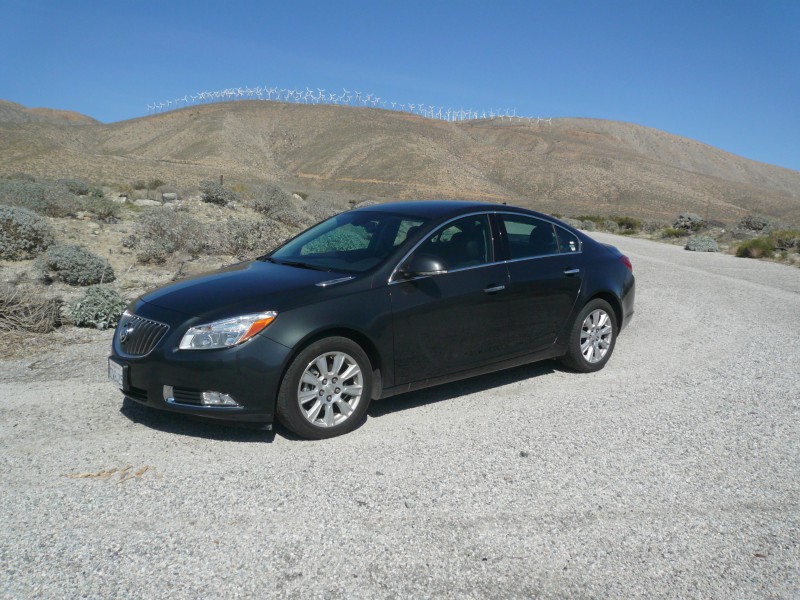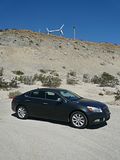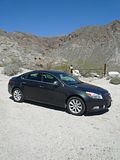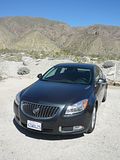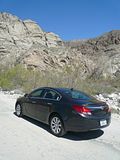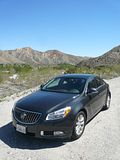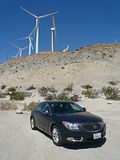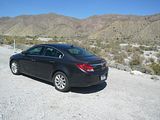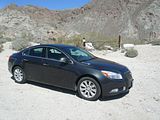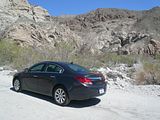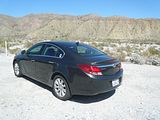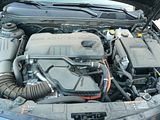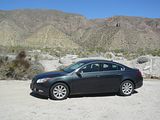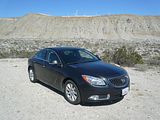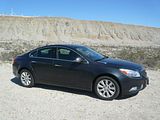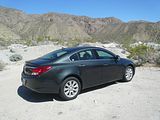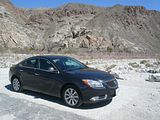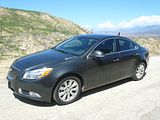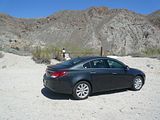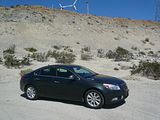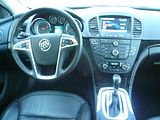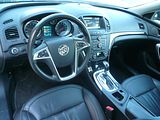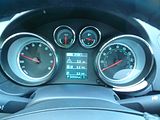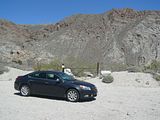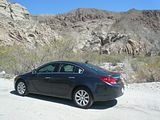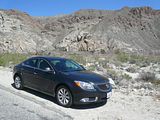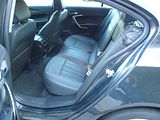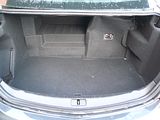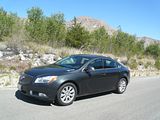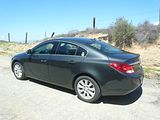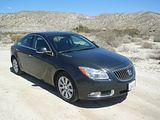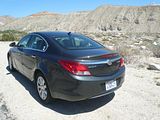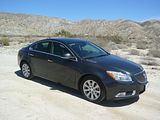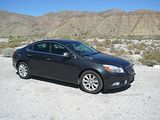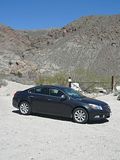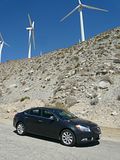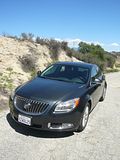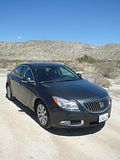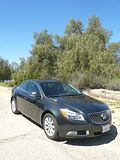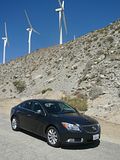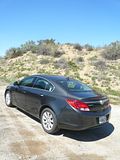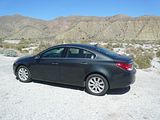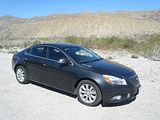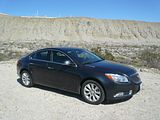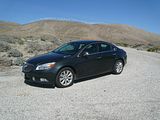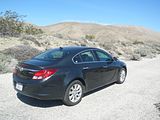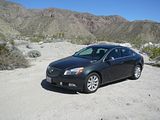
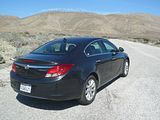
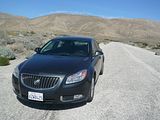
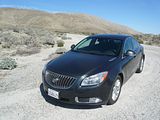
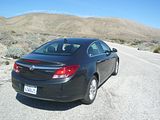
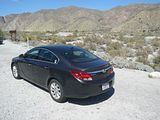
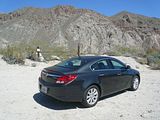
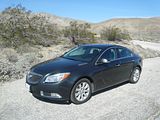
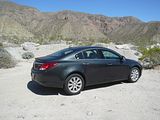
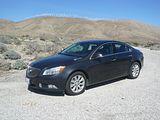



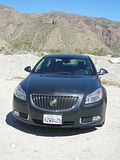
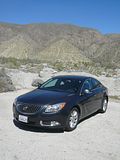
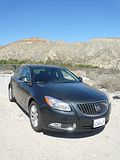

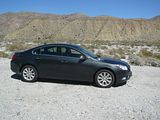
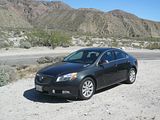

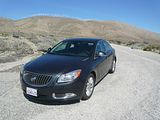
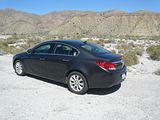
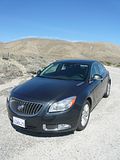
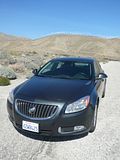
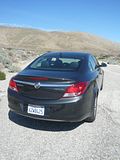
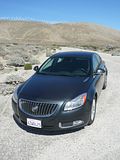

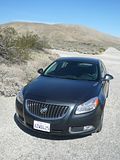
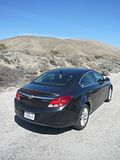
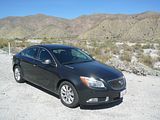
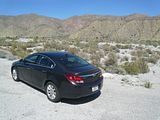

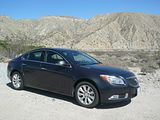
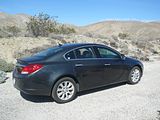

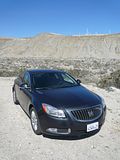
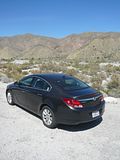
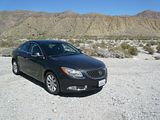
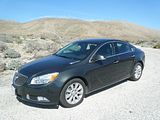

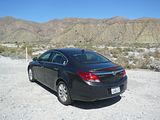
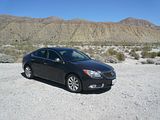
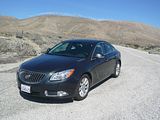
Although I had spotted Turbo badging on the rump of the facelifted for 2014 Regals that have started to appear in the rental facilities, on my test car there was nothing to indicate the engine that was fitted or the trim level. A quick look under the bonnet revealed that my test car had GM’s familiar 2.4 litre Ecotec engine. It generates 182 bhp, and is the same unit as had been in the Chevrolet Equinox that I had sampled a few days previously. In that car it got quite gruff once you made it work hard, but in the Regal, you would not know that you had the same engine at all, as the unit was smooth and refined, and overall noise suppression was particularly effective. What I did not realise, and I confess it did not even dawn on me when I had seen the boot, was that in fact I had what you could call a Hybrid model. Buick call it eAssist, and this amounts to a lithium-ion battery housed in the boot, along with regenerative braking, engine stop/start, fuel cut-off, grille louvres that close at speed, underbody panels and low-rolling resistance tyres. The eAssist system adds up to 15 hp (11 kW) to the standard 2.4 litre Ecotec engine during acceleration. When you come to a standstill, say at traffic lights, the petrol engine cuts out, leaving the car just on the battery. Press the accelerator pedal and the cutting back in of the petrol engine is far smoother and less obtrusive than any Stop/Start system I have ever encountered. It helps deliver results at the pump, too. I was impressed by the overall economy that I achieved, netting out at 34.5 mpg US (41.2 mpg Imperial). Granted most of the test was conducted at a steady speed on the freeway, but even so, this is a very respectable result indeed. Standard transmission is a 6 speed automatic, which has a manual mode if you are so inclined. There is a very long travel on the gearlever between positions, so I found quite often that when going from reverse to drive, I had not gone far enough, and ended up in neutral. This was more often the case when pushing the lever forwards rather than pulling it back all the way.
Although Buick might like you to think of the Regal as a sports sedan, in his version at least, they are kidding themselves. It comes across very much as the luxury boulevardier, not something that you would enjoy punting down a twisty road. The steering is not overly light, but it did not have a huge amount of feel to it. The handling felt safe, with only a trace of understeer and a smidgeon of body roll on tighter turns. Whilst there was nothing wrong with it, I just would not call it remotely sporty. The soft suspension probably contributes to that impression, too, as it gives a nice compliant ride. The brakes worked well. There is an electronic handbrake, operated by a small push/pull lever set behind the gearlever. The one area that did concern me was the visibility. The rear screen is quite steeply raked and the tail drops off, so you certainly cannot see it, but there are parking sensors fitted. However, the problem came from the door mirrors. Thanks to the very cut off shape, these leave a dangerously large blind spot where vehicles quite a long way behind you simply vanish from view. If ever there was a candidate for the excellent blind spot mirrors that GM put on some of their larger vehicles, this is the car.
Open the door of the Regal and you can see that this is trimmed to a far higher standard than you would get in a fleet/rental version of the Insignia. Not only are the seats fully covered in leather, but so is much of the dashboard (it has gloss black inlays as well and judicious but relatively sparing use of chrome highlighting) and most of the door casings, as well as the steering wheel and the transmission selector. With everything fitting together nicely, the interior certainly hits the luxury feeling ambience right away. The basic design of the dashboard is exactly the same as the Insignia, though. That means a curved instrument binnacle which covers the two large dials of rev counter on the left and speedometer on the right. Set between them, in the upper area of the instrument nacelle are two dials, a fuel gauge on an “Eco” gauge. This has a green area between about 8 o’clock and 4 o’clock on the arc of the needle, and white areas to either side. As there were no calibrations, I could not be very clear what it was really telling me, but the needle seemed to spend most of its time somewhere in the green area. Below this is a digital display area which has exactly the same functions as I experienced in the other GM vehicles I tested recently, with a mix from trip mileage to average fuel consumption and any service warnings. You cycle between these by twisting the end of the left hand column stalk, and there is a “menu” button in that stalk to switch between the two sets of menus. The column stalks are GM US type, not the one-touch European ones, with indicators operated from the left and wipers from the right. A rotary dial to the left of the wheel operates the lights. The centre of the dash contains the display screen for GM’s MyLink audio infotainment setup. Again, having experienced this in three cars within the preceding couple of weeks, this proved very easy to use (far easier than Ford’s My Ford Touch), with some of the functions operated by touch on the screen. There are an awful lot of buttons in a panel below the screen, for all the radio functions, some of which are also repeated with smaller buttons on the steering wheel spokes. Below this are the buttons for the climate control, and again, there are quite a few of these, so the central part of the dash does look a bit busy, but it is all quite easy to use, and it is not as fussy as recent Ford layouts.
Adjustment of the front seats is electric in all directions, and there is a tilt and telescopic adjustment to the steering wheel as well, so getting a comfortable driving position was not hard. The seat itself was all part of the smooth and luxury feeling of the Regal, proving very agreeable to sit on for a number of hours as I drive the car around. I recall that when I first saw the Insignia, and tried to sit in the back, the lack of rear headroom was quite startling, so I was pleasantly surprised to find that there were no such issues with the Regal. There’s width aplenty for three adults to sit across the back seat, and even when the front seats are well back, there is sufficient legroom. There is a central drop down armrest. When I looked in the boot, I should have guessed that the large area on the right that is taken up, and has battery markings on it is more than just your average 12 volt appliance. It does take out quite a lot of what is not a vast boot in the first place, meaning that you lose quite a lot of the depth from back to front on one side of the car. The rear seat backrests do fold down, so you can get more space if you need it. Inside the Regal, there is a generous glove box, average sized door pockets and a modest but deep cubby under the central armrest.
For the 2013 model year, the eAssist model was available with four trim versions, Base, Premium 1, Premium 2 and Premium 3. The only differences between the $29.015 Base and the $30,635 Premium 1 seems to be that the latter has a vehicle anti-theft system, universal remote garage opener, keyless starting and rear parking sensors, heated steering wheel and power operation of the front passenger seat and since these all featured on the test car, I am guessing that mine was a Premium 1. Even the Base model is quite well equipped, coming with leather trim, electrically adjustable front seats, the driver’s being heated, dual zone climate control, cruise control, MyLink with XM satellite radio, CD slot, Bluetooth, AUX and MP3 connectivity, GM OnStar, split folding rear seats, leather wrapped steering wheel and gearlever, with wheel mounted controls. Offered at $32,045, the Premium 2 has an upgraded 9 speaker Harman-Kardon audio system. Premium 1 and 2 models were also available with the 220 bhp 2.0 Turbo petrol engine for the same price as the eAssist model. The $33,215 Premium 3 was only available with the 2.0T, and among other differences had 19″ alloy wheels as standard and the top of the range $34,980 GS came with a more powerful 270 bhp 2 litre Turbo and adjustable suspension that has three modes. All Turbo models are available with a six speed manual gearbox as an option.
As I’ve yet to drive an Insignia, I cannot meaningfully comment on the transition to the US spec Regal, but I clearly can pass judgment on the Buick that I drove. Indeed, when I went to Hertz to collect the next test car, I was asked what I thought of it,. and I said something along the lines of: “it was very agreeable, though not quite the sports sedan that Buick would like you to perceive, but if you want a nicely finished and very serene freeway cruiser that is very good on fuel, then the Regal has much to commend it”, and indeed it has. In the US market, I would say that despite Car & Driver pitting it against a 3 series and a Mercedes CLA, neither of which are aimed at quite the same sort of market niche, its two biggest rivals in the quasi premium sector are probably the VW CC and the Volvo S60. I’ve driven the latter, in Spain, a few years ago, before the latest revisions and new engines, but never sampled the CC. Hertz have them both on fleet, so they are now on the list of cars to sample, so I can conclude which would be my favourite of the three. It will not be a Slam Dunk for any of them, I am pretty sure.

